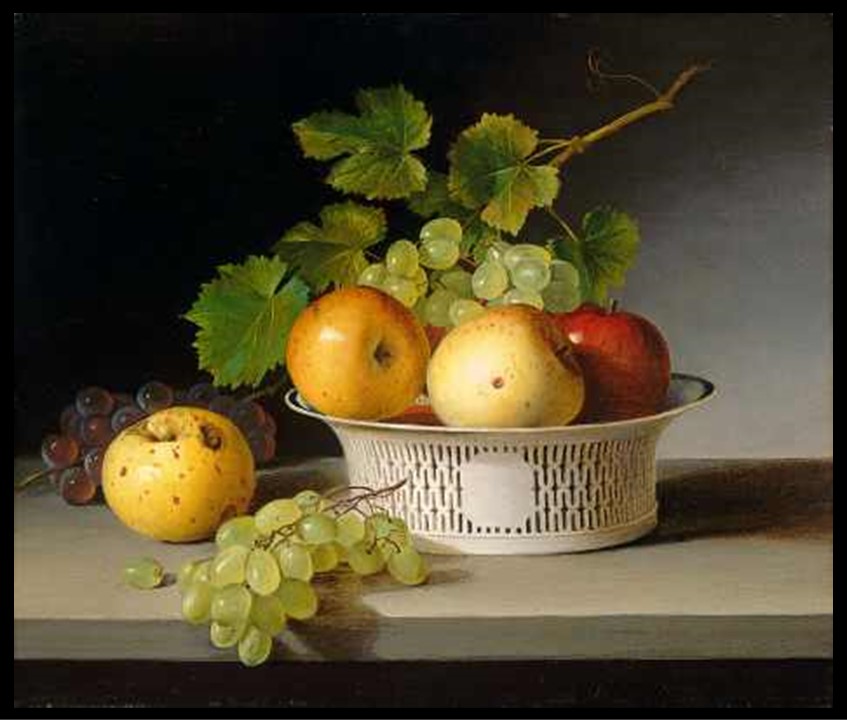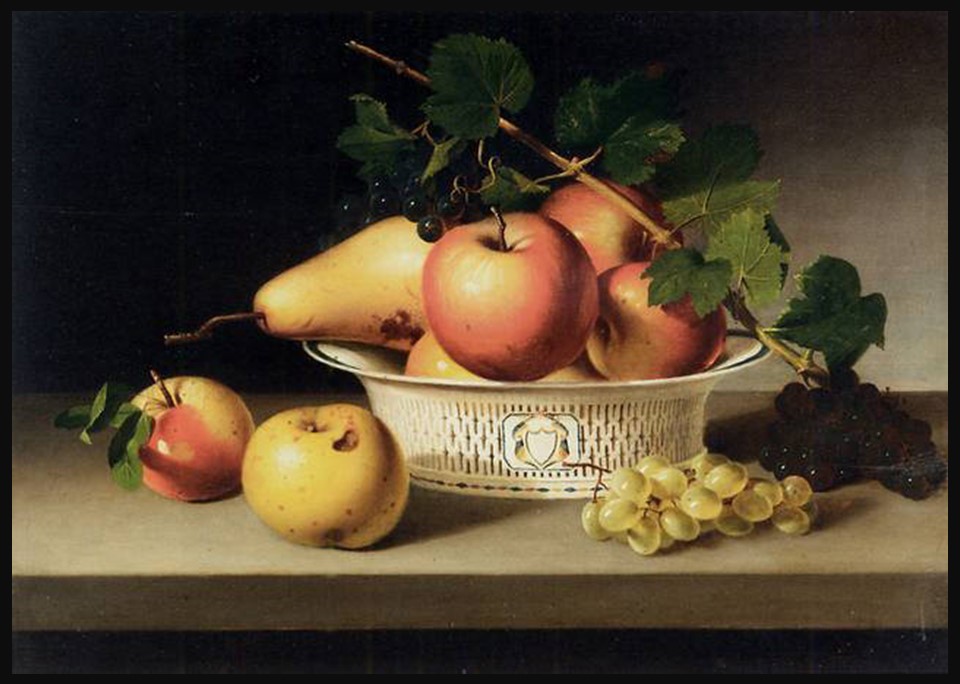
Fruit Still Life with Chinese Export Basket, 1824, Oil on Wood, 37.8 x 45.6 cm, National Gallery of Art, Washington DC, USA
https://www.nga.gov/collection/art-object-page.71370.html
Season of mists and mellow fruitfulness, / Close bosom-friend of the maturing sun; / Conspiring with him how to load and bless / With fruit the vines that round the thatch-eves run; / To bend with apples the moss’d cottage-trees, / And fill all fruit with ripeness to the core; / To swell the gourd, and plump the hazel shells / With a sweet kernel; to set budding more, / And still more, later flowers for the bees, / Until they think warm days will never cease, / For summer has o’er-brimm’d their clammy cells… We find an evocative celebration of nature’s abundance in the harmony between John Keats’ ode to autumn and James Peale’s Fruit Still Life with Chinese Export Basket. Keats’ season of mists and mellow fruitfulness resonates with Peale’s thorough portrayal of ripened fruit—both works capture the fullness and quiet beauty of harvest time. Keats personifies the maturing season as a conspirator with the sun, swelling fruit to its ripest state, while Peale visually echoes this fullness with rich detail and vibrant colour. Together, they invite reflection on the fleeting yet generous nature of life’s bounty. https://www.poetryfoundation.org/poems/44484/to-autumn
James Peale (1749–1831) was a prominent American painter, known for his contributions to Portraiture, Still Life, and Miniature painting. Born in Chestertown, Maryland, Peale was part of a highly artistic family, most notably the younger brother of Charles Willson Peale, one of the most famous American artists of the time. Initially trained as a saddler, James Peale later joined the Continental Army during the American Revolution, where he served as a soldier while pursuing his passion for art. After the war, he apprenticed with his brother Charles, learning the fine art of painting. By the 1780s, James had established himself as a skilled portraitist, known particularly for his miniatures, which were highly sought after by wealthy patrons of the time. As part of the renowned Peale family of artists, James influenced the next generation, including his daughters Sarah Miriam Peale and Anna Claypoole Peale, who became notable painters themselves. His contribution to American still life painting marks him as a pivotal figure in the genre’s development.
In the early 19th century, James Peale shifted his artistic focus to still life painting, where he demonstrated an exceptional ability to capture the intricate textures and vibrant colours of natural objects, particularly fruit. His works, such as Fruit Still Life with Chinese Export Basket of 1824, are celebrated for their precision, balance, and depth, conveying not only the beauty of ripened Fruits of Autumn but also symbolic themes of abundance and transience.

Fruits of Autumn, c. 1829, oil on panel, 39.3 x 55.9 cm, Private Collection https://commons.wikimedia.org/wiki/File:James_Peal%27s_oil_painting_%27Fruits_of_Autumn%27.jpg
Peale’s still lifes stand out for their meticulous attention to detail and masterful use of light and composition. In his work, James Paele achieves a striking realism that invites viewers to reflect on the richness and fragility of nature. His ability to elevate simple, everyday objects into subjects of contemplation helped redefine still life painting in America, transforming it from decorative art into a more meaningful exploration of life’s fleeting abundance. Peale’s influence laid the groundwork for future American artists, establishing still life as a respected and serious genre in the United States.
James Peale’s Fruit Still Life with Chinese Export Basket, a delicate interplay of light and shadow brings to life a serene arrangement of fruit. A speckled yellow apple, blemished by a wormhole, rests beside lush bunches of purple and green grapes, cascading over a sand-colored stone shelf. To the right, an intricately designed white basket, adorned with dark blue trim and pierced with graceful patterns, cradles more apples and grapes. The fruit gleams under soft light from the upper left, illuminating the textured surfaces and vibrant colours, while the background shifts from a luminous silvery grey to a deep shadow, creating a sense of depth and contrast. Peale’s attention to detail, from the delicate curve of the leaves to the subtle imperfections in the fruit, evokes both natural beauty and the passage of time, offering a glimpse into the ephemeral richness of nature.
For a Student Activity inspired by James Peale’s painting Fruit Still Life with Chinese Export Basket, please… Check HERE!
Bibliography: https://www.nga.gov/collection/artist-info.6676.html and https://www.jstor.org/stable/1005692 and https://tfaoi.org/aa/8aa/8aa142.htm